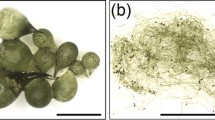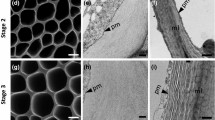Summary
The formation and development of linear terminal complexes (TCs), the putative cellulose synthesizing units of the red algaErythrocladia subintegra Rosenv., were investigated by a freeze etching technique using both rotary and unidirectional shadowing. The ribbon-like cellulose fibrils ofE. subintegra are 27.6 ± 0.8 nm wide and only 1–1.5 nm thick. They are synthesized by TCs which are composed of repeating transverse rows formed of four particles, the TC subunits. About 50.4 ± 1.7 subunits constitute a TC. They are apparently more strongly interconnected in transverse than in longitudinal directions. Some TC subunits can be resolved as doublets by Fourier analysis. Large globular particles (globules) seem to function as precursor units in the assembly and maturation of the TCs. They are composed of a central hole (the core) with small subunits forming a peripheral ridge and seem to represent zymogenic precursors. TC assembly is initiated after two or three gobules come into close contact with each other, swell and unfold to a nucleation unit resembling the first 2–3 transverse rows of a TC. Longitudinal elongation of the TC occurs by the unfolding of globules attached to both ends of the TC nucleation unit until the TC is completed. The typical intramembranous particles observed inErythrocladia (unidirectional shadowing) are 9.15 ± 0.13 nm in diameter, whereas those of a TC have an average diameter of 8.77 ± 0.11 nm. During cell wall synthesis membranes of vesicles originating from the Golgi apparatus and which seem to fuse with the plasma membrane contain large globules, 15–22 nm in diameter, as well as ‘tetrads” with a particle diameter of about 8 nm. The latter are assumed to be involved in the synthesis of the amorphous extracellular matrix cell wall polysaccharides. The following working model for cellulose fibril assembly inE. subintegra is suggested: (1) the ribbon-like cellulose fibril is synthesized by a single linear TC; (2) the number of glucan chains per microfibril correlates with the number of TC subunits; (3) a single subunit synthesizes 3 glucan chains which appear to stack along the 0.6 nm lattice plane; (4) lateral aggregation of the “3-mer” stacks leads to the crystalline microfibril.
Similar content being viewed by others
References
Brown RM Jr (1985) Cellulose microfibril assembly and orientation: recent developments. J Cell Sci Suppl 2: 13–32
—, Montezinos D (1976) Cellulose microfibrils: visualization of biosynthetic and orienting complexes in association with the plasma membrane. Proc Natl Acad Sci USA 73: 143–147
—, Franke WW, Kleinig H, Falk H, Sitte P (1970) Scale formation in chrysophycean algae. I. Cellulosic and noncellulosic wall components made in the Golgi apparatus. J Cell Biol 45: 246–253
Delmer DP (1987) Cellulose biosynthesis. Annu Rev Plant Physiol 38: 259–290
Evans LV, Callow ME, Percival E, Fareed W (1974) Studies on the synthesis and composition of extracellular mucilage in the unicellular red algaRhodella. J Cell Sci 16: 1–21
Gargiulo GM, De Masi F, Tripodi G (1987) Thallus morphology and spore formation in culturedErythrocladia irregularis Rosenvinge (Rhodophyta, Bangiophycidae). J Physiol 23: 351–359
Giddings TH Jr, Brower DL, Staehelin LA (1980) Visualization of particle complexes in the plasma membrane ofMicrasterias denticulata associated with the formation of cellulose fibrils in the primary and secondary cell walls. J Cell Biol 84: 327–339
Guiry MD, Gunningham EM (1984) Photoperiodic and temperature responses in the reproduction of northeastern AtlanticGigartina acicularis (Rhodophyta: Gigartinales). Phycologia 23: 357–367
Haigler CH, Brown RM Jr (1986) Transport of rosettes from the Golgi apparatus to the plasma membrane in isolated mesophyll cells ofZinnia elegans during differentiation to tracheary elements in suspension culture. Protoplasma 134: 111–120
Herth W (1983) Arrays of plasma membrane “rosettes” involved in cellulose microfibril formation ofSpirogyra. Planta 159: 347–356
Hotchkiss AT Jr, Brown RM Jr (1987) The association of rosette and globule terminal complexes with cellulose microfibril assembly inNitella translucens var.axillaris (Charophyceae). J Phycol 23: 229–237
Itoh T (1990) Cellulose synthesizing complexes in some giant marine algae. J Cell Sci 95: 309–319
Mizuta S, Brown RM Jr (1992) High resolution analysis of the formation of cellulose synthesizing complexes inVaucheria hamata. Protoplasma 166: 187–197
Mueller SC, Brown RM Jr (1980) Evidence for an intramembrane component associated with a cellulose microfibril-synthesizing complex in higher plants. J Cell Biol 84: 315–326
Northcote DH (1985) Control of cell wall formation during growth. In: Brett CT, Hillman JR (eds) Biochemistry of plant cell walls. Cambridge University Press, Cambridge, pp 177–197
— (1991) Site of cellulose synthesis. In: Haigler CH, Weimer PJ (eds) Biosynthesis and biodegradation of cellulose. Marcel Dekker, New York, pp 165–176
Okuda K, Brown RM Jr (1992) A new putative cellulose-synthesizing complex ofColeochaete scutata. Protoplasma 168: 51–63
—, Tsekos I, Brown RM Jr (1994) Cellulose microfibril assembly inErythrocladia subintegra Rosenv.: an ideal system for understanding the relationship between synthesizing complexes (TCs) and microfibril crystallization. Protoplasma 180: 49–58
Pueschel CM (1979) Ultrastructure of tetrasporogenesis inPalmaria palmata (= Rhodophyta). J Phycol 15: 409–424
Quader H (1991) Role of linear terminal complexes in cellulose synthesis. In: Haigler CH, Weimer PJ (eds) Biosynthesis and biodegradation of cellulose. Marcel Dekker, New York, pp 51–69
Ramus J (1972) The production of extracellular polysaccharide by the unicellular red algaPorphyridium aerugineum. J Phycol 8: 97–111
Starr RC, Zeikus JA (1987) UTEX — the culture collection of algae at the University of Texas at Austin. J Phycol 23 Suppl: 1–47
Tsekos I (1981) Growth and differentiation of the Golgi apparatus and wall formation during carposporogenesis in the red alga,Gigartina teedii (Roth) Lamour. J Cell Sci 52: 71–84
— (1985) The endomembrane system of differentiating carposporangia in the red algaChondria tenuissima: occurrence and participation in secretion of polysaccharidic and proteinaceous substances. Protoplasma 129: 127–136
—, Reiss H-D (1988) Occurrence and transport of particle “tetrads” in the cell membrane of the unicellular red algaPorphyridium visualized by freeze-fracture. J Ultrastruct Mol Struc Res 99: 156–168
— — (1992) Occurrence of the putative microfibril-synthesizing complexes (linear terminal complexes, TCs) in the plasma membrane of the epiphytic marine red algaErythrocladia subintegra Rosenv. Protoplasma 169: 57–67
— — (1993) The supramolecular organization of red algal vacuole membrane visualized by freeze-fracture. Ann Bot 72: 213–222
— —, Schnepf E (1993) Cell-wall structure and supramolecular organization of the plasma membrane of marine red algae visualized by freeze-fracture. Acta Bot Neerl 42: 119–132
Author information
Authors and Affiliations
Additional information
Dedicated to Prof. Dr. Dr. h.c. Eberhard Schnepf on the occasion of his retirement
Rights and permissions
About this article
Cite this article
Tsekos, I., Okuda, K. & Brown, R.M. The formation and development of cellulose-synthesizing linear terminal complexes (TCs) in the plasma membrane of the marine red algaErythrocladia subintegra Rosenv.. Protoplasma 193, 33–45 (1996). https://doi.org/10.1007/BF01276632
Received:
Accepted:
Issue Date:
DOI: https://doi.org/10.1007/BF01276632




